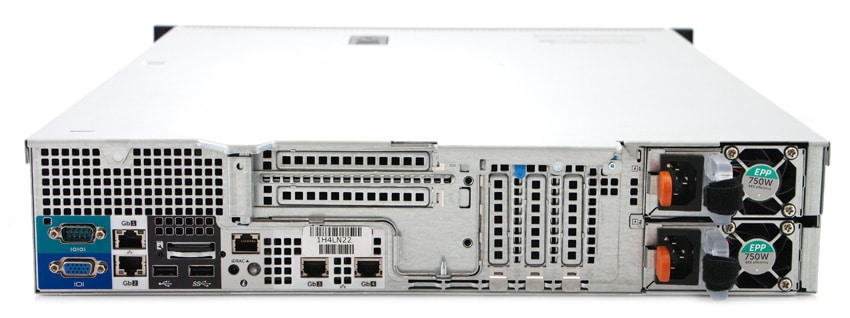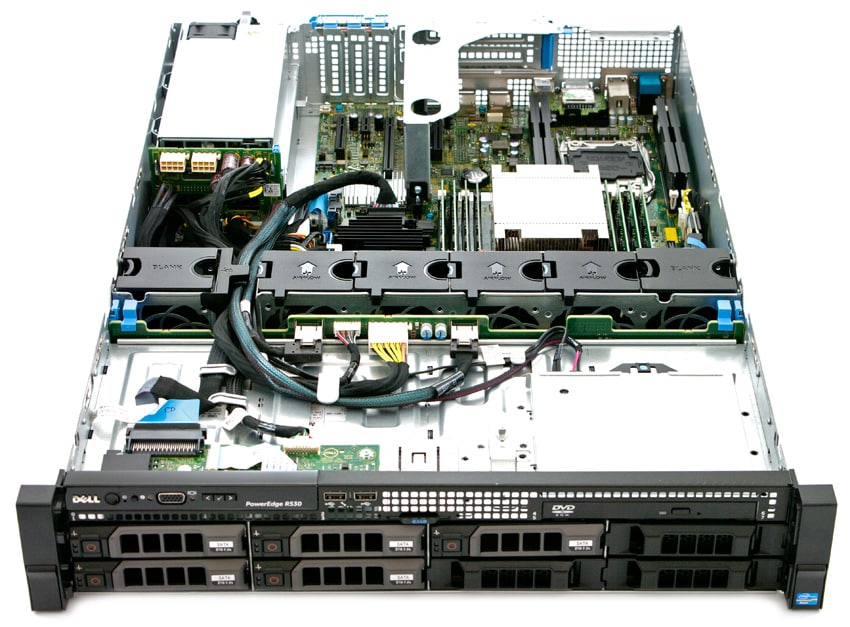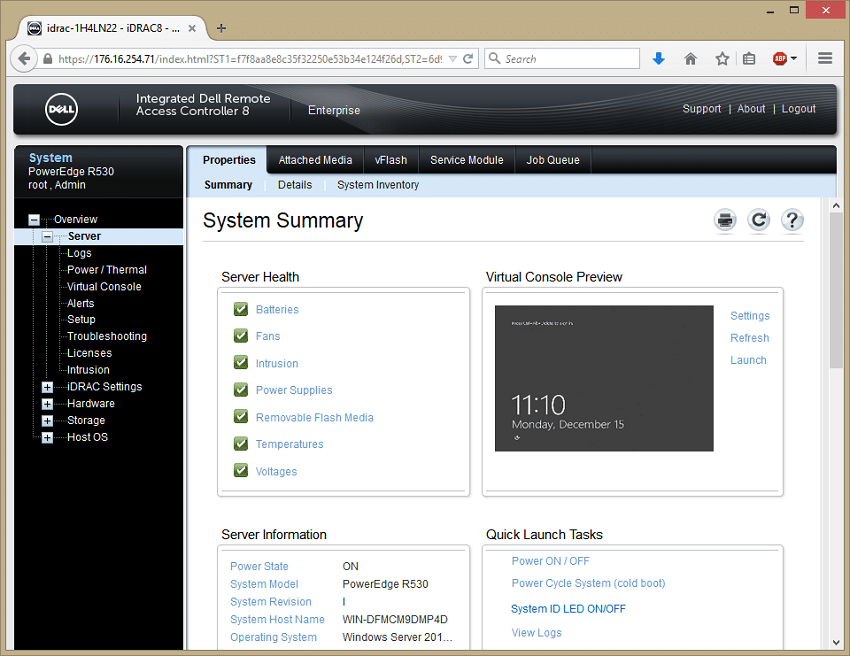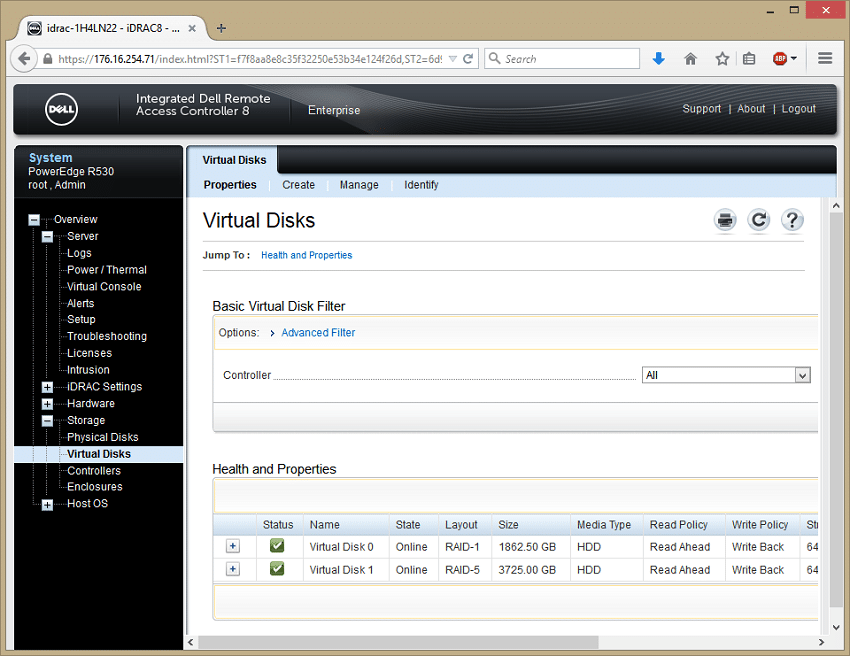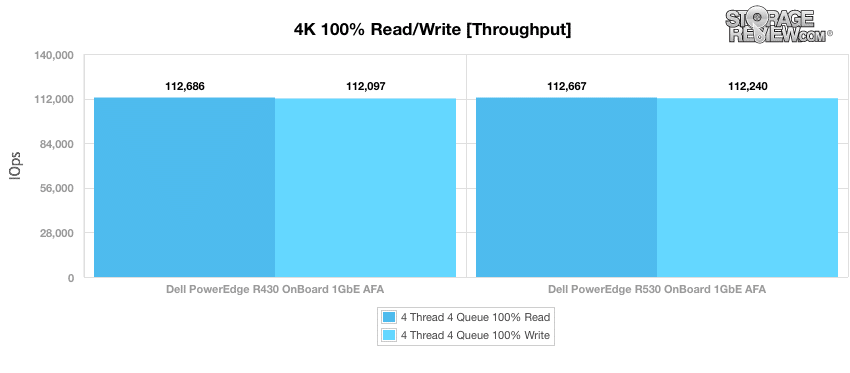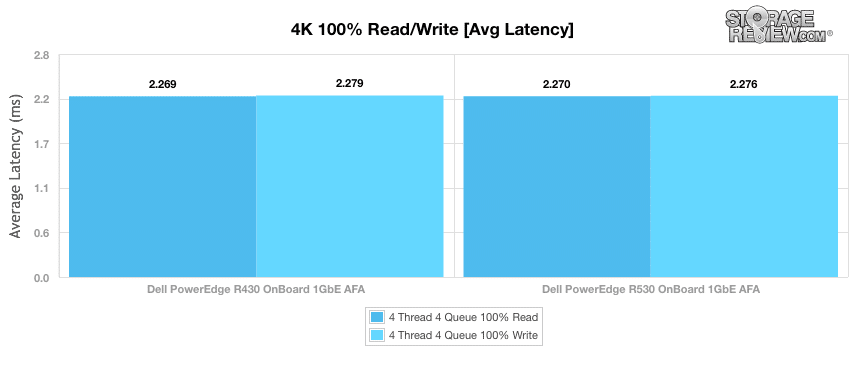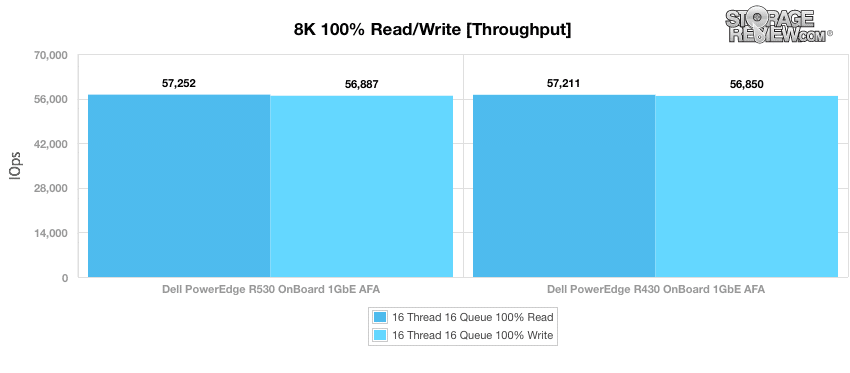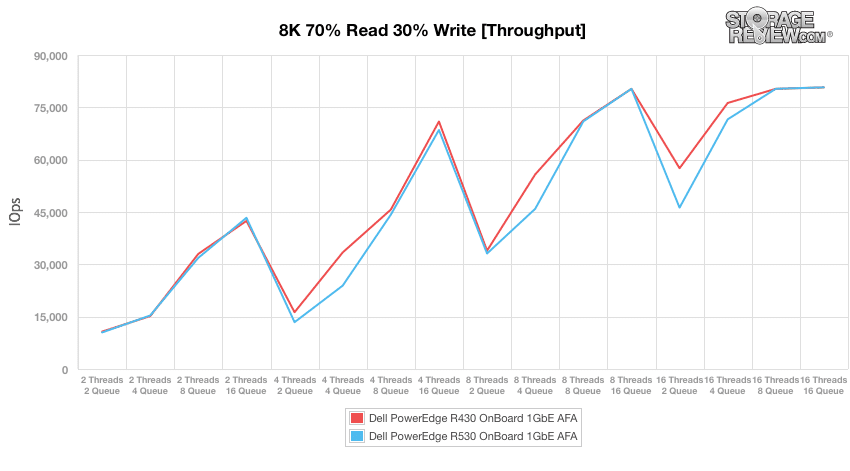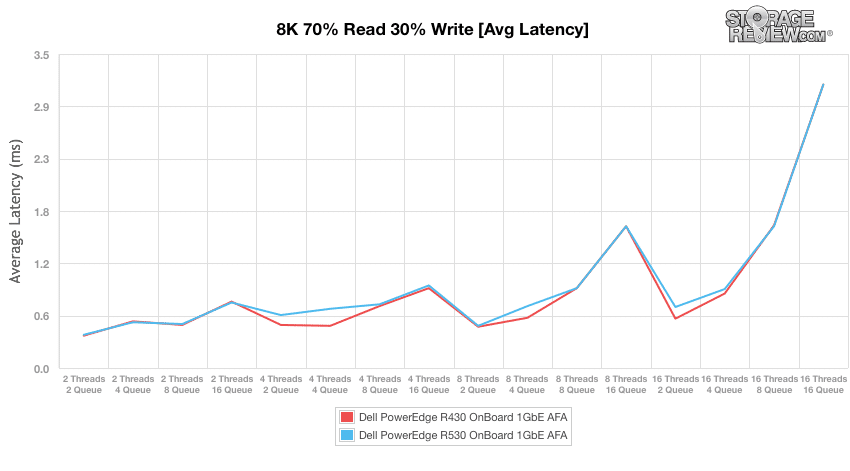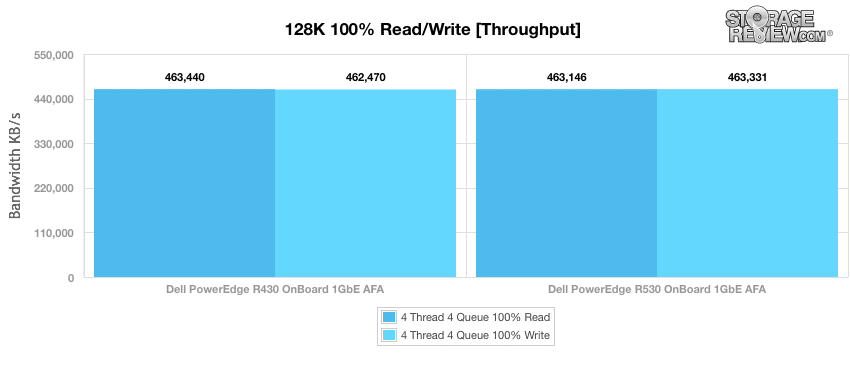
The Dell PowerEdge 13G R530 is a 2U rack server engineered for midrange and virtualized workloads with two sockets for Intel Xeon E5-2600 v3 processors. The R530 is built with Intel’s Grantly architecture and a Wellsburg C610 chipset that supports 12 DDR4 DIMM slots, 2 PCIe 2.0 slots, and 3 PCIe 3.0 slots. With a single chassis layout option that features 3.5-inch drive bays, the R530 is oriented towards use cases that require storage density over storage performance.
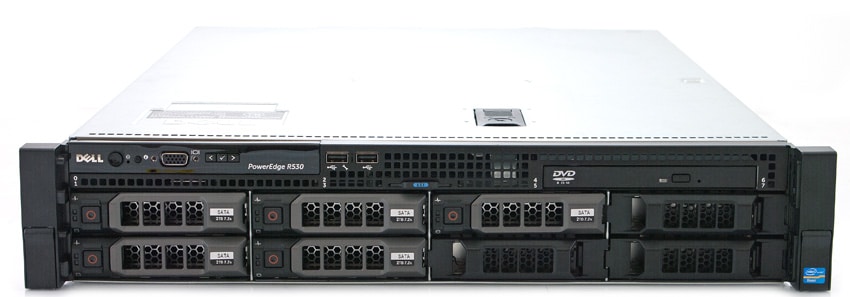
As with other current PowerEdge offerings, the R530 is built with Dell’s Remote Access Controller 8 (iDRAC8) with Lifecycle Controller as the foundation of its management functionality. iDRAC8 provides agent-free management capabilities for streamlining server deployment, configuration, and updates.
This review features a R530 configured exclusively with hard drives, although the 13G PowerEdge platform uses Dell's new PERC9 controllers. PERC9 controllers replace the LSI CacheCade technology used in Dell's PERC8 controllers with a DAS Cache solution from SanDisk. DAS Cache uses "filter driver" for the operating system in order to accelerate performance by caching frequently used data on SSDs. Our review of the PowerEdge 13G R730xd takes a closer look at the functionality and performance of the DAS Cache feature.
Our evaluation of the R530 will utilize this server as the compute component for a benchmark protocol which uses an all-flash array configured with Micron P420m PCIe SSDs as the underlying storage media. We will review the R530 in tandem with a review of the PowerEdge R430 which in many respects serves as a 1U variation of the same design.
Dell PowerEdge 13G R530 Specifications
- Chassis: 2U rack (8.68cm x 48.24cm x 66.8cm H/W/D)
- Processor: Intel Xeon processor E5-2600 v3 product family
- Chipset: Intel C610 series chipset
- Operating Systems
- Microsoft Windows Server 2008/2012 SP2, x86/x64 (x64 includes Hyper-V )
- Microsoft Windows Server 2008/2012 R2, x64 (includes Hyper-V )
- Novell SUSE Linux Enterprise Server
- Red Hat Enterprise Linux
- VMware vSphere
- Memory: 12 DDR4 DIMMs at up to 2133MT/s (4GB/6GB/16GB/32GB)
- Hypervisor Support
- Citrix XenServer
- Microsoft Windows Server 2008, with Hyper-V
- VMware vSphere ESXi
- Drive Bays: Up to 8 x 3.50inch SAS, SATA, nearline SAS, SSD drives
- Up to 5 x PCIe slots (half-length, low-profile): 3 x PCIe 3.0; 2 x PCIe 2.0
- Internal RAID Controllers
- PERC S130
- PERC H330
- PERC H730
- PERC H730P
- External RAID Controller: PERC H830
- Network Controller: 4 x 1 GbE LOMs
- Power
- 495W, 750W, 1100W hot-plug PSU
- 550W cabled PSU
- Availability
- ECC memory
- Single Device Data Correction (SDDC)
- Spare Rank
- Hot-plug hard drives
- Hot-plug redundant power
- iDRAC8 with Lifecycle Controller
- Support for HA clustering
- Virtualization-ready
- Internal Dual SD Module (Failsafe Hypervisor)
- TPM 1.2
- Graphics Card
- Video Type :Integrated Matrox G200 with iDRAC8
- Video Memory: 16 MB shared with iDRAC8 application memory
- Systems management
- IPMI 2.0 compliant
- Dell OpenManage Essentials
- Dell OpenManage Mobile
- Dell OpenManage Power Center
- Remote management
- iDRAC8 with Lifecycle Controller
- iDRAC8 Express (default)
- iDRAC8 Enterprise (upgrade)
- 8GB vFlash media (upgrade)
- 16GB vFlash media (upgrade)
- iDRAC Quick Sync
- Dell OpenManage Integrations
- Dell OpenManage Integration Suite for Microsoft System Center
- Dell OpenManage Integration for VMware vCenter
- Dell OpenManage Connections
- HP Operations Manager
- IBM Tivoli Netcool and CA Network and Systems Management
- Dell OpenManage Plug-in for Oracle Database Manager
Build and Design
The top-left corner of the R530’s front panel incorporates its power button next to an NMI troubleshooting button designed to be pressed using the end of a paper clip and a system identification button that can be used to visually locate the server within a rack. Moving rightward, the front panel also features a VGA monitor port and an LCD panel and monitoring interface that displays system ID, status information, and error messages. One of the front panel’s two USB 2.0 ports also doubles as the system’s iDRAC management port.
The back panel includes a serial port and VGA port at left, next to two integrated 10/100/1000Mbps Ethernet ports. Moving to the right, the panel incorporates space for an optional vFlash media card slot and an optional iDRAC port above a USB 2.0 port, a USB 3.0 port, and the system identification button and system identification connector. PowerEdge 13G chassis configurations that utilize an optional expansion card riser offer two full-height PCIe slots above the remaining two Ethernet ports and three half-height PCIe slots to the right of the ports. Configurations without the riser offer five half-height PCIe slots to the right of the ports.
The R530 features five cooling fans behind the drive bays and their backpane. The CPU sockets are staggered and placed between the system’s DDR4 slots. The R530 can be configured with an optional PCIe riser which allows the use of two full-height PCIe 3.0 slots and three half-height slots. Without the riser, the system offers five half-height PCIe slots.
Management
As a member of the 13G PowerEdge family, the R430 implements the Dell OpenManage platform, powered by the Integrated Dell Remote Access Controller 8 (iDRAC8) with Lifecycle Controller. For agent-based management deployments, Dell's OpenManage Server Administration (OMSA) offers one-to-one system management from the command line or a Web GUI. Because management workflows are similar across the 13G PowerEdge lineup, this review will feature an overview of its management functionality. Our review of the PowerEdge 13G R730xd incorporates a fuller look into iDRAC and the 13G PowerEdge DAS Cache functionality for configurations which combine hard drive and flash storage media.
iDRAC can provide remote access to the system whether or not there is an operating system installed. After login, iDRAC displays a system overview as well as a virtual console preview via its iKVM.
iDRAC Direct allows administrators to use a USB key to deploy hardware configurations to 13G PowerEdge servers, including BIOS, iDRAC, PERC, and NIC settings. iDRAC Direct also allows administrators to access the iDRAC management GUI via a laptop connected to the server via a USB cable. The iDRAC Quick Sync capability allows administrators with Android-powered mobile devices to touch optional iDRAC Quick Sync hardware in the front bezel of a 13G PowerEdge server to view server status and logs.
Testing Background and Comparables
We publish an inventory of our lab environment, an overview of the lab's networking capabilities, and other details about our testing protocols so that administrators and those responsible for equipment acquisition can fairly gauge the conditions under which we have achieved the published results. To maintain our independence, none of our reviews are paid for or managed by the manufacturer of equipment we are testing.
Our intention for this review is to provide a baseline of synthetic enterprise results to help potential customers evaluate the R430's performance. Therefore our benchmarking protocol for R530 will compare its performance to a similarly-configured Dell PowerEdge 13G R430. Both the R430 and the R530 have been used to drive synthetic benchmark workloads on an all-flash array with Micron P420m PCIe SSDs as the storage media. Both servers were connected to the array via their onboard 1GbE interfaces and both servers utilize the SMB protocol.
Enterprise Synthetic Workload Analysis
Prior to initiating each of the fio synthetic benchmarks, our lab preconditions the device into steady-state under a heavy load of 16 threads with an outstanding queue of 16 per thread. Then the storage is tested in set intervals with multiple thread/queue depth profiles to show performance under light and heavy usage.
Preconditioning and Primary Steady-State Tests:
- Throughput (Read+Write IOPS Aggregated)
- Average Latency (Read+Write Latency Averaged Together)
- Max Latency (Peak Read or Write Latency)
- Latency Standard Deviation (Read+Write Standard Deviation Averaged Together)
This synthetic analysis incorporates four profiles which are widely used in manufacturer specifications and benchmarks:
- 4k – 100% Read and 100% Write
- 8k – 100% Read and 100% Write
- 8k – 70% Read/30% Write
- 128k – 100% Read and 100% Write
After being preconditioned for 4k workloads, both PowerEdge servers were able to sustain both read and write workloads at approximately 112,000IOPS.
Average latency calculations for the 4k benchmark were likewise very similar for both servers and comparable across read and write operations. In each instance the average latency calculations were approximately 2.3ms.
After being preconditioned for 8k workloads, both servers were able to maintain read and write throughputs of approximately 57,000IOPS.
With a workload composed of a mixture of 8k read and write operations the R430 was able to edge out the performance of the R530 on workloads that featured shallow queue depths.
Average latency calculations during the 8k 70/30 benchmark also reflected slightly better performance by the R430 with shallow queues.
Our final synthetic benchmark made use of 128k transfers and a workload of 100% read and 100% write operations. Through this lens the two PowerEdge servers were again nearly indistinguishable with approximately 463,000IOPS for read and write operations.
Conclusion
The PowerEdge 13G R530 is a general purpose 2U compute platform combined with a chassis form factor that maximizes storage density with 3.5-inch drive bays but also provides room for up to five PCIe cards for application accelerators, HBAs, and other components. As the iDRAC management platform continues to mature it has only become easier to configure a server like the 13G R530 as an individual unit or as part of a larger PowerEdge deployment. OpenManage Essentials also provides access to Dell’s OpenManage Mobile technology for portable devices and can automate PowerEdge bare-metal and OS deployments. The 13G PowerEdge family also incorporates Dell's Failsafe Hypervisor technology for redundancy that protects virtual workloads.
Within Dell's PowerEdge portfolio, the R530 makes its play as a value-oriented 2U server with little complexity, but also few options in terms of storage at least. For more configurable storage options, the R730 family is a better place, but also more expensive. For mainstream use cases or for businesses wanting to take advantage of DAS Cache in an affordable chassis, the R530 has a lot to offer. It also does well as a redundant compute node accessing shared storage, much like the smaller 1U R430 cousin.
Pros
- Chassis layout for dense internal storage
- Up to five PCIe expansion slots with the use of a riser
- Entry pricing allows flexible and affordable starting configurations
Cons
- Trade-off of maximum supported DRAM compared to R730
- Up to 8 3.5-inch drive bays only
The Bottom Line
The Dell PowerEdge 13G R530 is well-suited to a variety of use cases that can leverage its 3.5-inch drive bays for dense internal storage and its high-performance Xeon E5-2600 v3 compute architecture.
Dell PowerEdge R530 Product Page

